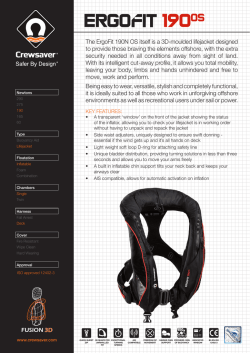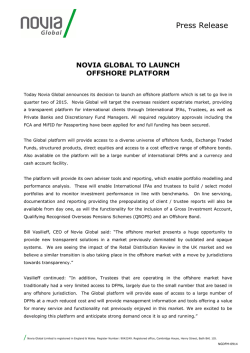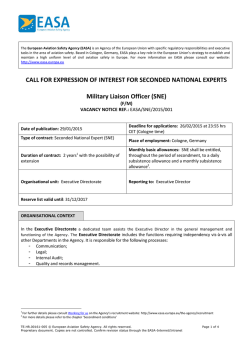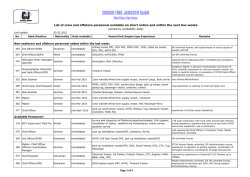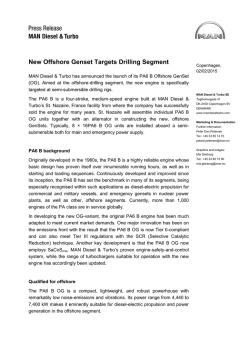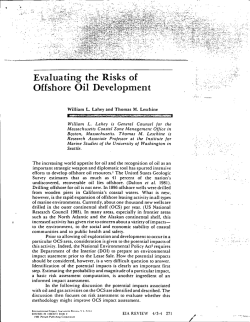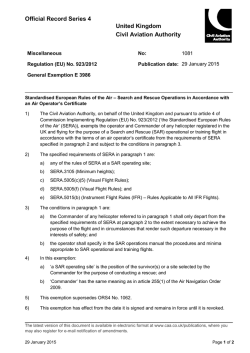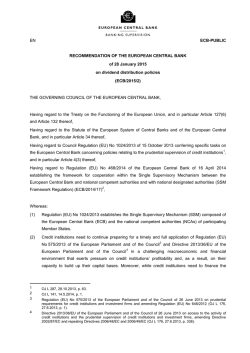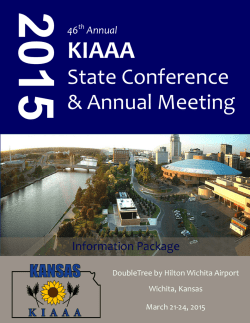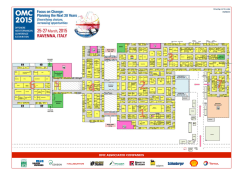
Safety Directive SD-2015/001
Civil Aviation Authority SAFETY DIRECTIVE Number: SD–2015/001 Issued: 28 January 2015 Offshore Helicopter Operations At Annex 1 to this Safety Directive is an Operational Directive mandating action that is required to restore an acceptable level of safety. The Operational Directive is issued in accordance with Article 15 of the Air Navigation Order 2009. Recipients must ensure that this Directive is copied to all members of their staff who need to take appropriate action or who may have an interest in the information (including any ‘in-house’ or contracted maintenance organisation and relevant outside contractors). Applicability: Aerodromes: Not primarily affected Air Traffic: Not primarily affected Airspace: Not primarily affected Airworthiness: Not primarily affected Flight Operations: All AOC Helicopter Operators Conducting Offshore Operations Licensed Personnel: Not primarily affected 1 Introduction 1.1 This Safety Directive (SD) promulgates the Operational Directive (see Annex 1) issued by the Civil Aviation Authority (CAA) on 14 October 2014 and is applicable to operators conducting offshore Public Transport (PT) or Commercial Air Transport (CAT) helicopter operations in support of offshore oil, gas and mineral exploration, production, storage and transport. 1.2 Following concerns raised by recent helicopter accidents in the seas around the UK, the CAA conducted a Safety Review of Offshore Public Transport Helicopter Operations in association with the Norwegian CAA and the European Aviation Safety Agency (EASA). The report of the review was published in CAP 1145 and a progress report on actions and recommendations arising is at CAP 1243. 1.3 SD-2014/002 incorporated several changes and additional requirements including Actions A9 and A10 of CAP 1145, and the schedule for making the SD applicable to operations which are for the purposes of sea-pilot transfer or the support for the offshore renewable energy industry. 1.4 This SD supersedes SD-2014/002, in order to include several minor editorial changes and specifically to update the guidance quoted in Annex 3. The Operational Directive itself has not been changed from the version published in SD-2014/002. Page 1 of 8 Civil Aviation Authority Safety Directive SD-2015/001 2 Reason and Explanation 2.1 This SD is made in the interests of passenger safety and survivability for the reasons set out in Chapter 9 of CAP 1145. 2.2 The review identified areas of passenger survivability that needed addressing including improving the prospects of rescue following a ditching, together with mitigating the consequences of capsize. This Directive requires action to be taken by helicopter operators in line with this principle and will be kept under review by the CAA Offshore Safety Action Group that has been established, under the chairmanship of the Director Safety and Airspace Regulation Group, as a result of the review. 3 Implementation 3.1 The CAA has been working with Oil and Gas UK and the helicopter operators to facilitate the introduction and approval of appropriate Emergency Breathing Systems (EBS) for use by passengers. The aim was to establish the integration of appropriate systems with other elements of survival equipment, such as life jackets and immersion suits, and to ensure that any necessary training was formulated and implemented. Through significant effort and cooperation, EBS meeting the Category A specification of CAP 1034 has been developed and distributed with appropriate training completed. 3.2 JAR-OPS 3.837(a)(6) required that all doors, windows or other openings, in their specific helicopter passenger compartments, identified as suitable for the purpose of underwater escape and that are equipped so as to be operable in an emergency be authorised by the authority; this requirement is now covered under CAT.IDE.H.310(f). The CAA has worked with the helicopter operators to achieve these authorisations. CAP 562 (Civil Aviation Airworthiness Information and Procedures), Book 2, Leaflet 44-30 (Helicopter Emergency Escape Facilities) provides guidance on interpretation of the requirements and recommended standards for emergency escape facilities for use should the helicopter capsize after a ditching (but see Annex 3 for revised wording). Operators of foreign registered helicopters should seek authorisation through their own national aviation authorities. 3.3 Due to concerns about the wider impact on the safety of the offshore industry as a whole that the seating restrictions of Action A8 of CAP 1145 would impose, especially during the busy summer months of 2014, the CAA decided to delay the implementation from 1 June to 1 September 2014. However, the intention to require all occupants to have EBS available from 1 April 2016 (Action A10) has been partially brought forward with all passengers required to have EBS by 1 January 2015; the all occupants requirement remains as 1 April 2016 which in effect means that the flight crew will also require EBS by then. These dates are now incorporated into the Operational Directive. 3.4 The CAA, working in conjunction with EASA, the helicopter manufacturers and the operators, clarified the ditching certification basis for all offshore helicopter types. This information was necessary for the operators to apply the requirements of Action A6 regarding limitation of flight over water with sea conditions above those of the helicopter demonstrated ditching performance. Implementation for this restriction was achieved by 1 September 2014. During this period, EASA consulted on Airworthiness Directives (ADs) covering the same subject. Subsequently, ADs have been issued for offshore helicopter types effective from 1 September 2014 with the requirement to be implemented within three months of that date. This action requires the relevant Rotorcraft Flight Manual to be amended to include additional notifications. The CAA will continue dialogue with EASA to assess the implications of the implementation of the ADs. 3.5 In identifying the condition of the sea over which an offshore flight might be expected to travel, operators are to have procedures that use the most appropriate and available information. This process should at least include accessing the sea surface information provided by the UK Met Office and should encapsulate both current and forecast conditions. The CAA expects Page 2 of 8 Civil Aviation Authority Safety Directive SD-2015/001 that the Significant Wave Height (SWH) information for the entire route (to offshore destination, any inter-rig or location sectors and return journey) provided by the UK Met Office will be used for planning and at the departure decision stage only. Once departed, the flight should continue at the commander's discretion and in accordance with the operator's procedures. SWH parameters are taken from the World Meteorological Organisation sea state codes. 4 Extension of Applicability 4.1 The focus of the original SD was aimed at the more established area of offshore operations in support of the oil and gas industry. However, other sectors of PT/CAT helicopter aviation that have a substantial proportion of any flight conducted over open sea areas are exposed to similar hazards and risk. Regulation (EU) No. 965/2012 (Air Operations) already includes sea pilot transfer within the scope of offshore operations (this applied from 28 October 2014) and support for the renewable energy industry and marine lights are planned to be included within the amendment to the regulation by the introduction of the Specific Approval (SPA) for Offshore Helicopter Operations (HOFO) as promulgated in the EASA Notice of Proposed Amendment 2013-10 and the reaction in Comment Response Document 2013-10. 4.2 The CAA is keeping the requirements of this SD under review and has determined to align its applicability with the UK application of Regulation (EU) No. 965/2012 and any amendments arising from the introduction of HOFO. 4.3 Consequently, the CAA decided that the provisions of this SD should be extended to operators of offshore operations in support of sea pilot transfer and the renewable energy industry. Therefore the SD was amended in October 2014 to introduce a scheduled timescale for the application of the various elements of the requirements. Consideration has been given to the need for new and compatible lifejacket/EBS equipment, particularly with a view to helicopter hoist operations, to become available. Support for marine lights will be addressed separately and while the status and regulatory basis for such operations is determined; however, the CAA expects that, in the meantime, such operators will review their operating safety analysis and apply similar safety precautions to those detailed in this SD where appropriate. 5 Interpretation 5.1 As well as the definitions in the Operational Directive at Annex 1, Annex 2 includes extracts of relevant UK legislation. 6 Queries 6.1 Any queries or requests for further guidance from AOC holders as a result of this communication should be addressed to the assigned Flight Operations Inspector in the first instance. 6.2 Otherwise, queries should be addressed to the following e-mail address: [email protected]. 7 Cancellation 7.1 This Directive will remain in force until revoked by the CAA. Page 3 of 8 Civil Aviation Authority Safety Directive Annex 1 SD-2015/001 Operational Directive Directive 1 The CAA, in exercise of its powers under article 15 of the Air Navigation Order 2009, directs the operator (‘a specified operator’) of any helicopter which is: (a) registered in the United Kingdom; or (b) flying in the United Kingdom or in the neighbourhood of an offshore installation; to comply with the requirements set out in paragraphs 3 to 7. 2 This Directive is made in the interests of safe operations for the reasons set out in Chapter 9 of CAP 1145, the CAA safety review into offshore helicopter operations. Requirements 3 Subject to paragraphs 8 to 11, a specified operator must not commence a public transport or a commercial air transport offshore operation unless the requirements in paragraphs 4, 5, 6 and 7 are met. 4 (a) The significant wave height of the sea over which the flight is intended to be conducted to or from an offshore location is 6 metres or less. (b) The significant wave height of the sea over which the flight is intended to be conducted to or from an offshore location does not exceed the certificated ditching performance of the helicopter. (c) The specified operator has ensured that procedures are in place to require Emergency Floatation Systems to be armed as appropriate for all overwater arrivals and departures. (d) Only passenger seats that are immediately adjacent to an exit authorised by the CAA, or relevant national aviation authority, as suitable for the purpose of underwater escape are used. 5 From 1 January 2015, all passengers are wearing specified breathing apparatus. 6 From 1 April 2015, all passengers when wearing the required safety and survival equipment are seated in a seat row corresponding to an underwater escape exit authorised by the CAA, or associated national aviation authority, compatible with their size. 7 From 1 April 2016, all occupants are wearing specified breathing apparatus. Exceptions 8 9 10 Subparagraphs 4(a), (b) and (d) and paragraphs 5, 6 and 7 do not apply to: (a) any operational search and rescue flights; or (b) a flight for the purpose of responding to an emergency on an offshore location. Subparagraph 4(d) does not apply if at least one of the following criteria is met: (a) all passengers are wearing specified breathing apparatus; or (b) the helicopter is fitted with EASA-approved side-floating, or equivalent, emergency floatation equipment providing an air gap in the cabin. Paragraphs 5 and 7 do not apply if the helicopter is fitted with EASA-approved side-floating, or equivalent, emergency floatation equipment providing an air gap in the cabin. Page 4 of 8 Civil Aviation Authority Safety Directive SD-2015/001 Transitional Arrangements 11 On offshore operations for the purposes of sea-pilot transfer or the support of offshore wind turbines and other renewable energy sources: (a) subparagraphs 4(a) and (b) do not apply until 28 October 2014; (b) subparagraph 4(d) does not apply until 1 April 2015; and (c) paragraphs 5 and 6 do not apply until 1 April 2016. Definitions 12 In this Directive: (a) (b) ‘Offshore operation’ means a helicopter operation that has a substantial proportion of any flight conducted over open sea areas to or from an offshore location for the purpose of: i) the support of offshore oil, gas and mineral exploration, production, storage and transport; ii) sea-pilot transfer; or iii) the support of offshore wind turbines and other renewable energy sources. ‘Offshore location’ means a facility intended to be used for helicopter operations on either: i) an offshore installation or a renewable energy installation as defined in the Civil Aviation Act 1982; or ii) floating structures or vessels. (c) ‘Significant wave height’ means the average value of the height (vertical distance between trough and crest) of the largest one-third of the waves present. (d) ‘Specified breathing apparatus’ means Emergency Breathing Systems (EBS) that meet Category ‘A’ of the specification detailed in CAP 1034, or equivalent, and are authorised by the CAA as suitable for the purpose of emergency underwater breathing where their fitment to emergency suits or life jackets is approved by EASA as not interfering with emergency use. Revocation and Commencement 13 Operational Directive SD-2014/001 dated 1 June 2014 is revoked. 14 This Directive comes into force on 14 October 2014 and will remain in force until revoked by the CAA. Page 5 of 8 Civil Aviation Authority Safety Directive Annex 2 SD-2015/001 Extracts of Legislation Extracts from Civil Aviation Act 1982, Schedule 13, Part III, Extra-territorial Provisions 6 (5) So far as relates to any provision of an Order in Council or regulation concerning aircraft on or in the neighbourhood of offshore installations, within the meaning of the Mineral Workings (Offshore Installations) Act 1971, this paragraph shall apply to all aircraft and not only to aircraft registered in the United Kingdom and shall apply to the doing of anything in relation to any aircraft by any person irrespective of nationality or, in the case of a body corporate, of the law under which it was incorporated. (6) Sub-paragraph (5) above shall apply to installations notwithstanding that they are for the time being in transit. (7) So far as relates to a provision of an Order in Council or regulation concerning aircraft on or in the neighbourhood of a renewable energy installation, this paragraph— (a) shall apply to all aircraft, and not only to aircraft registered in the United Kingdom; and (b) shall apply to the doing of anything in relation to an aircraft by any person, irrespective of nationality, or (in the case of a body corporate) of the law under which it was incorporated. (8) For the purposes of sub-paragraphs (5) and (7) the neighbourhood of an installation includes anywhere within 500 metres of that installation. (9) In this paragraph “renewable energy installation” has the same meaning as in Chapter 2 of Part 2 of the Energy Act 2004. Extracts from Offshore Installations and Pipeline Works (Management and Administration) Regulations 1995 Meaning of “offshore installation” 3.(1) Subject to the provisions of this regulation, in these Regulations the expression “offshore installation” means a structure which is, or is to be, or has been used, while standing or stationed in relevant waters, or on the foreshore or other land intermittently covered with water— (a) for the exploitation, or exploration with a view to exploitation, of mineral resources by means of a well; (b) for the storage of gas in or under the shore or bed of relevant waters or the recovery of gas so stored; (c) for the conveyance of things by means of a pipe; or (d) mainly for the provision of accommodation for persons who work on or from a structure falling within any of the provisions of this paragraph, and which is not an excepted structure. Meaning of “relevant waters” 2.(1) In these Regulations, unless the context otherwise requires— “relevant waters” means— (a) tidal waters and parts of the sea in or adjacent to Great Britain up to the seaward limits of territorial waters; and (b) any area designated by order under section 1(7) of the Continental Shelf Act 1964. Page 6 of 8 Civil Aviation Authority Safety Directive SD-2015/001 Extract from Energy Act 2004 104 Interpretation of Chapter 2 of Part 2 (3) In this Chapter “renewable energy installation” means— (4) (5) (a) an offshore installation used for purposes connected with the production of energy from water or winds; (b) an installation in the course of construction at a place where it is to be used as an offshore installation within paragraph (a); (c) an installation that has ceased to be an installation within paragraph (a) while remaining an offshore installation (whether or not at the same place); (d) an installation that is being decommissioned at a place where it has been an installation within paragraph (a) or (c); (e) an installation in transit to or from a place where it is to be, or has been, used for purposes that would make it, or made it, an installation within paragraph (a); (f) an installation in transit to or from a place where it is to be, or was, an installation within paragraph (c). In subsection (3) “offshore installation” means an installation which is situated in waters where— (a) it permanently rests on, or is permanently attached to, the bed of the waters; and (b) it is not connected with dry land by a permanent structure providing access at all times for all purposes. The purposes referred to in subsection (3)(a) include, in particular— (a) the transmission, distribution and supply of electricity generated using water or winds; and (b) the doing of anything (whether by way of investigations, trials or feasibility studies or otherwise) with a view to ascertaining whether the generation of electricity in that manner is, in a particular case, practicable or commercially viable, or both. UK Continental Shelf Limit (Illustrative) Page 7 of 8 Civil Aviation Authority Safety Directive Annex 3 SD-2015/001 Amended CAP 562, Book 2, Leaflet 44-30 1 During the development of meeting the requirements for emergency exits as determined by JAR-OPS 3.837(a)(6) (see paragraph 3.2 of SD) and as explained within CAP 1145, it has been necessary to amend the guidance provided by CAP 562 (Civil Aviation Airworthiness Information and Procedures), Book 2, Leaflet 44-30 (Helicopter Emergency Escape Facilities). CAP 562 will be amended in due course to reflect this new guidance and the text will be forwarded to EASA to be considered for inclusion in HOFO. 2 Paragraph 3 of Leaflet 44-30 is replaced with the following: 3 Underwater Escape Exits 3.1 Evidence from trials indicates that, for unobstructed rectangular exits, persons whose bi-deltoid (shoulder) width is less than the diagonal taken between the corner radii and whose maximum thorax (chest) depth is less than the width will be able to escape when wearing all required personal protective equipment (PPE – e.g. survival suits, life jackets, emergency breathing system). 3.2 The minimum aperture size acceptable for use as an underwater escape exit is defined as a diagonal measurement between the corner radii of 559 mm (22”) and a width of 356 mm (14”). These minimum dimensions apply to the aperture available following operation of the exit as briefed (e.g. with the rubber seals in place for push-out windows, unless passengers are briefed to remove them prior to egress or it can be demonstrated that they will detach with the window). For non-rectangular exits or partially obstructed (e.g. by a seat back) exits, the exit must be capable of admitting an ellipse of 559 mm x 356 mm (22” x 14”). 3.3 Passengers whose bi-deltoid (shoulder) width is greater than 559 mm (22”) must be allocated to seats having direct access to a Part-29.807 Type IV size (480 mm (19”) wide x 660 mm (26”) high) or larger exit. Means should be provided for readily confirming that larger passengers are correctly seated; this could be achieved through the use of patterned and/or colour-coded arm bands and matching seat headrests. 3.4 The means of opening underwater escape exits should be rapid and obvious, and involve no more than one simple action to release the exit prior to ejection of the exit. Underwater exit operation should be standardised at least within each helicopter type. Passenger safety briefing material should include instructions on the use of such escape facilities. Page 8 of 8
© Copyright 2026
